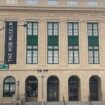
We are reader-supported and may earn a commission on purchases made through links in this article.
You might be surprised to hear that one of the most popular attractions in Las Vegas isn’t casino-related. In fact, it’s a museum – the Mob Museum. Located in downtown Vegas, approximately six miles from the Strip, this fascinating place is a visitor favorite.
Best Tips & Tools to Plan Your Trip
The Building is Part of the Attraction
The museum is housed in the first U.S. Courthouse and Post Office building in the city, which was constructed in the 1930s. The site is historic in its own right, as it served as a host to one of the well-known Kefauver Hearings on organized crime in 1950.
Visitors stroll the same hallowed halls as federal investigators, informants and mobsters once did, which lends a certain gravitas to the place.
Interestingly, though Vegas has a reputation for knocking down old buildings, rather than preserving them, the powers that be opted to save a few historic structures including this storied neoclassical example. It is said that even they knew better than to try and demolish it, as maybe they feared what they might discover lodged in the foundation!
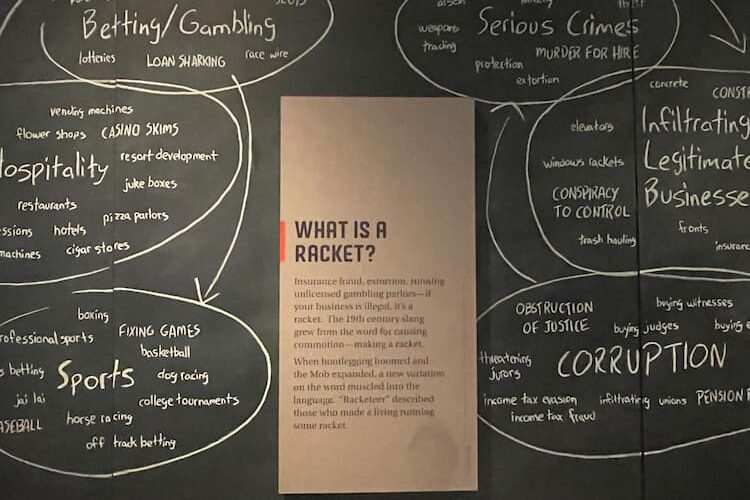
In 2002, the Feds sold the building to the City of Las Vegas for $1, stipulating that it be preserved and used as a cultural center, preferably a museum. The mayor at the time, Oscar Goodman, who had once represented mobsters as a defense attorney, proposed a museum that would delve into the complex history of the Mob and its mostly veiled role in society.
The Mob Museum officially opened on Feb. 14, 2012. It has since played a significant part in the revival of downtown Las Vegas.
Impressive on so many levels, the museum offers a fascinating, interactive journey that takes visitors from the birth of the Mob to the current state of organized crime in the U.S. and around the world.
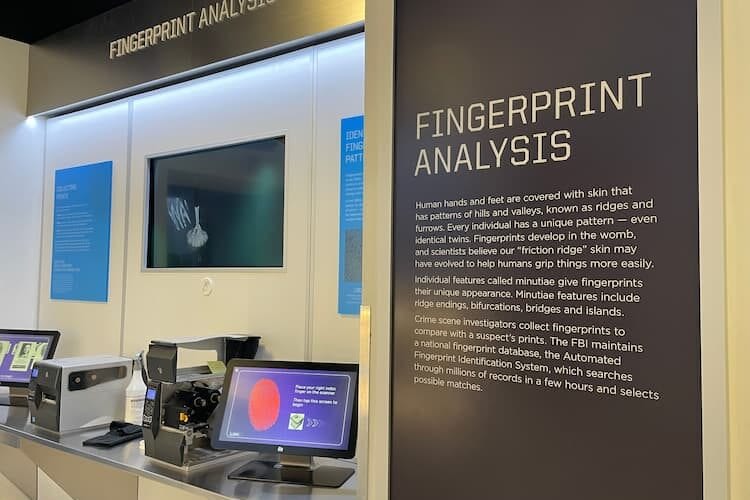
Museum’s Collection is Outstanding
The collection is vast and distributed over three floors. Engaging and detailed exhibits present an extensive array of artifacts and memorabilia, photos, video, audio and more, ensuring that consuming information never gets dull.
You’ll find ledgers, journals, firearms, even part of a wall from the famous St. Valentine’s Day Massacre, complete with bullet holes and blood stains. And alongside each artifact, picture, recording, etc. is the tale behind it.
The museum takes a no hold’s back approach, so expect to see some graphic and gruesome images and displays. Though it can be a bit much for some, I personally appreciated that history was told and shown as it was, and not dialed back or glossed over.
Galleries dig into the origins of organized crime (traced back to the urban ghettos of the late 19th century, where immigrants struggled to survive amid poverty, overcrowding and discrimination), Prohibition and the opportunities it offered to criminals, federal law enforcement response, the Kefauver Hearings, the Mob’s involvement in early Las Vegas, how the mob was finally reigned in and finally, what organized crime looks like today.
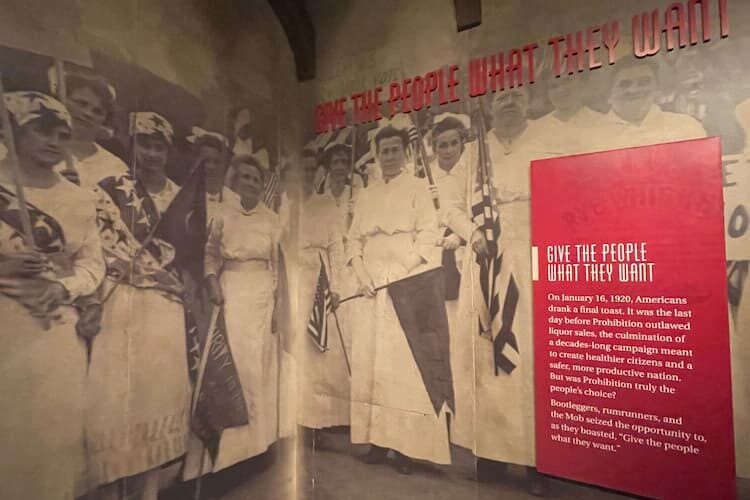
It’s a Who’s Who of the Underworld
Mob notables are introduced and presented throughout the museum, along with a litany of their crimes and eventual punishments. There’s everyone from Al Capone, Bugsy Siegal and Meyer Lansky to Lucky Luciano, Carlo Gambino, Frank Costello, Sam Giancana and more. It’s a who’s who of infamous mob bosses known to use violence to exert power and eliminate enemies.
Exhibit Highlights
Some of the exhibits that interested me the most included the above mentioned St. Valentine’s Day Massacre wall piece; the chair that the condemned sat in within Nevada’s gas chamber; a cash-lined room illustrating the clever “skim” scheme mob bosses devised to get a percentage of cash from the casinos before it was officially counted; wiretapped audio of conversations between mobsters; a model depicting El Chapo’s escape from prison; a step back in time to the Arizona Club casino; a room dedicated to historic Las Vegas artifacts and a web depicting how organized crime infected various civic institutions.
The latter theme dwells on public corruption and although I knew that organized crime has had its hand in many pots, it was shocking to see everything laid out in glaring detail. The Mob has bribed police officers to look the other way and bought politicians to obtain lucrative contracts.
But on a major scale, it has infiltrated some of the country’s most essential institutions, including collaborating with Jimmy Hoffa’s Teamsters Union to finance Las Vegas casino projects, dirtying its hands in the 1960 presidential election, controlling a range of industries such as cement companies and garment manufacturers and even conspiring with the CIA to attempt to assassinate Fidel Castro.
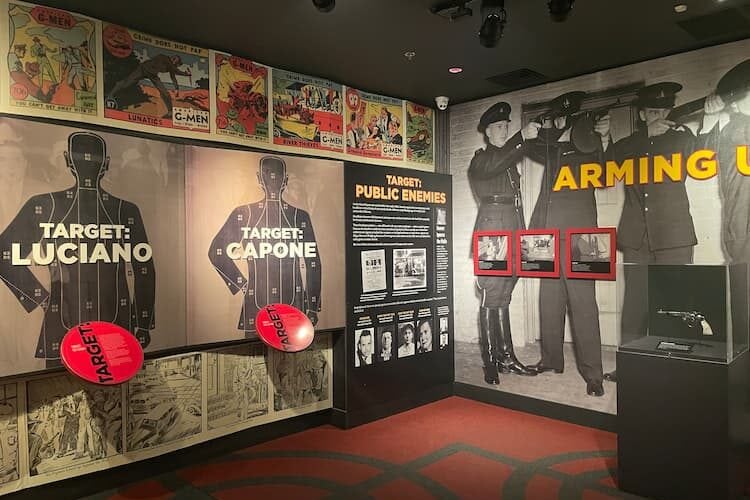
Kefauver Hearings Take Centerstage in the Courtroom
The piece de resistance, in my opinion, is the courtroom, now restored to its 1950s grandeur, where some of the Kefauver Hearings took place. Led by Tennessee Senator Estes Kefauver, the Kefauver Committee, as it became known, interviewed hundreds of witnesses in fourteen cities over fifteen months, in the first governmental attempt to expose the extent of organized crime in the U.S.
As you sit on the courtroom’s wooden benches and watch the videos, you’ll be immersed in a high-tech, multi-screen video production that presents testimony by several witnesses about organized crime involvement specific to the Las Vegas casino industry. It’s a riveting theatrical presentation.
Ultimately, the hearings confirmed the existence of a national crime syndicate and revealed lax enforcement, forcing the FBI and the government to publicly admit that such an organization existed.
People demanded a more aggressive campaign to bring down the Mob. Law enforcement agencies with new techniques and technologies, along with prosecutors who were able to use a new law enabling them to cut down the nation’s most powerful crime syndicates, eventually succeeded in reducing the Mob to a shadow of itself by the end of the 20th century.
Explore the Challenging Issues Regarding Use of Force
In another gallery, the use of excessive force is explored and the questions surrounding a law enforcement officer’s ability to make choices under dangerous conditions. This complex issue, so pertinent to today, from techniques to de-escalate volatile situations to the ultimate and last resort of pulling the trigger, continues to rouse public debate, as the tragedies mount up.
For an additional cost to the museum’s admission price, you can participate in the Firearm Training Simulator, which places visitors in the shoes of law enforcement officers and exposes them to the types of training exercises officers undergo in preparation for use-of-force situations.
You’ll engage in digital and live role-playing scenarios and need to find ways to de-escalate dangerous situations rather than resorting to deadly force. Participants receive a simulated firearm and police officer duty belt to use during the experience.
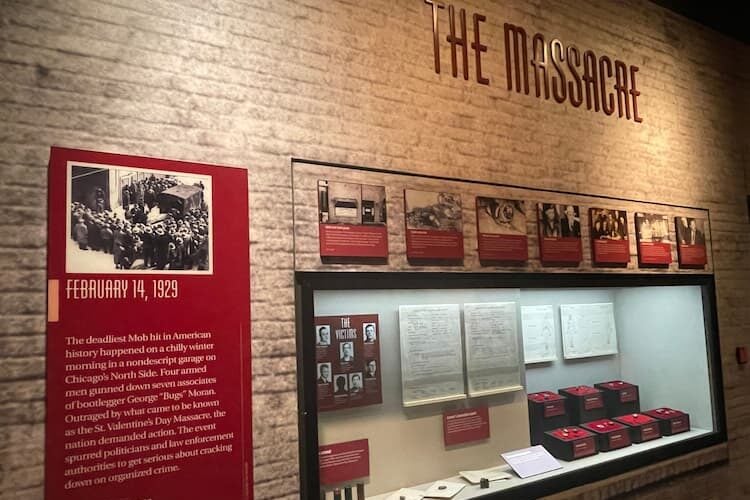
Crime Lab Experience is Top-Notch
A special ticket is also required for the Crime Lab Experience, which I chose to do. Important police work occurs not only on the streets, but also in the laboratory where finding and analyzing forensic evidence is the key to building strong cases against criminal suspects.
The experience in the lab allows visitors to explore the work of crime scene investigators, fingerprint analysts, DNA profilers, ballistics experts and medical examiners. Engaging in these forensic activities firsthand was an eye-opener as to the challenges such professionals are presented with on a daily basis.
In the fingerprint analysis section, I discovered that the mobster who shared my fingerprint subtype was one Jacob Drucker, a brutal hitman and member of Murder Incorporated, an organized crime group that acted as the muscle of the National Crime Syndicate. The group was believed to be responsible for hundreds of contract killings until it was exposed in 1941 by a former member.
Drucker was known for stabbing his victims with ice picks and severing their heads. He was tried and convicted of murder and sentenced to 25 years to life. He died in 1962 in Attica Prison. Nice to know…!
Global Reach of Organized Crime is Vast
To explore the world of organized crime today, there’s the Global Networks Touch Wall. Using a mix of media, maps, images and text, this vehicle details various prominent organized crime groups in the world, from Mexico’s drug cartels and Japan’s Yakuza to the Russian mafia, and their criminal schemes in detail.
You’ll learn that although the traditional Mob may have much less influence than it did years ago, organized crime still flourishes across the globe. And the crimes committed run the gamut from drug and trafficking (both humans and endangered and exotic species) to money laundering and cyber-scams. You’ll also find out what law enforcement agencies are doing to deal with these threats.
Check Out The Underground and Speakeasy
Before you leave the museum, make sure to check out the basement, where you can immerse yourself in The Underground. You’ll be surrounded by stories, images and artifacts from the 1920s as you stroll through a Prohibition Era-themed world.
For an extra fee, you can take a tour of the on-site distillery with its copper still and hear about the bootleggers and rum runners, while sampling a variety of distilled spirits. If you don’t opt for the tour, head directly to the Speakeasy for a taste of the bygone, with made-in-house moonshine, craft cocktails and a host of libations.
“Raise a glass to the past, drink what they drank and remember – you were never here.”
Inspire your next adventure with our articles below:
Author Bio: Debbie Stone is an established travel writer and columnist, who crosses the globe in search of unique destinations and experiences to share with her readers and listeners. She’s an avid explorer who welcomes new opportunities to increase awareness and enthusiasm for places, culture, food, history, nature, outdoor adventure, wellness and more. Her travels have taken her to nearly 100 countries spanning all seven continents, and her stories appear in numerous print and digital publications.

